|

2004
from
Jilaels Website
recovered through
WayBackmachine Website
Part 1
Disclaimer
This report is based on the work written by Mr. J. Drendl and
Mr. H. Hausdorf of the Ancient Astronaut Society. The
information presented herein has been thoroughly researched but does
not claim to be complete or accurate.
Contents
-
1937: The discovery of
the Stonedisks
-
1947: Dr. Karyl
Robin-Evans' expedition
-
1968: W. Saitsew & Prof.
Tsum Um Nui
-
1995: Ethnological
evidence?
1937: The
discovery of the Stonedisks
During an expedition to the hardly accessible mountain range of
Bayan-Kara-Ula which lies on the borderland between Tibet and China,
the Chinese archeologist Chi Pu Tei discovered several cave
burial sites which contained strange, only about 4 feet 4 inches
tall skeletons, whose heads were oversized in relation to their
otherwise slender frame.
In each of the total of 716 graves he found
a stonedisk with a diameter of about 1 foot and a thickness of a
third of an inch. These disks were engraved with inscriptions of so
far unknown origin.
Chi Pu Tei published his findings stating
that the skeletons were those of mountain gorillas and that the
disks were added by later cultures, which lead to him being
ridiculed by the Chinese archeologist community.
1947: Dr. Karyl Robin-Evans' expedition
The report
Shortly after World War II the polish professor Lolladoff
showed a strange stonedisk to the English scientist Dr. Karyl
Robin-Evans.
Lolladoff claims to have bought the disk in
Mussorie (Northern India) and that it is supposed to be from a
mysterious people called the "Dzopa" who had used it for
religious rituals.
In 1947 Dr. Robin-Evans made for the "mysterious land of the
Dzopa", traveling through Lhasa (Tibet) where he was
granted an audience with the 14th Dalai Lama. On the way to the very
inaccessible region to the northeast of the Himalaya, the English
scientist was abandoned by his Tibetan carriers - they were terribly
afraid of Baian-Kara-Ula - and only with tremendous effort did he
manage to reach his destination.
After having won the faith of the
locals, Dr. Karyl Robin-Evans was assigned a language-teacher
in order to introduce him to the basics of the Dzopa language and so
he learned from
Lurgan-La, religious guardian of the Dzopa, the history of the
Dzopa. Lurgan-La pointed out that they (Dzopa) originally came from
a planet in the Sirius-system.
There had been - about 20.000
years ago and again in the year 1014 - two exploration missions to
earth. In 1014 the crash took place that lead to the accidents
survivors being unable to leave earth again.
|
This picture taken
by Dr. Karyl Robin-Evans shows
the Dzopa ruling
couple
Hueypah-La (4
ft. tall) and Veez-La (3 ft. 4 in. tall).
Dr. Karyl Robin-Evans died in 1974.
The above report was
released in 1978. |
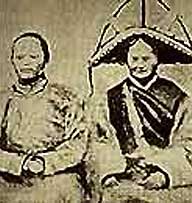
|
Comments
• The Dzopa are
often referred to as the Dropa. This is due to the fact that
the sound of the second consonant is in between a 'Z' and an 'R'.
• As Tibet wasn't under the rule of China in 1947, Dr.
Robin-Evans
trip could easily be arranged.
• It is well possible that Dr. Robin-Evans was received by a
"lineholder" instead of the Dalai Lama directly, a fact which could
be used to verify the correctness of Dr. Robin-Evans' report.
• Dr. Robin-Evans' report dates the crash to the year 1014,
all other sources however talk of a crash 12.000 years ago. This
discrepancy remains unexplained so far.
• According to Lurgan-La's history the Dzopa would appear to
be direct descendants of space traveling "aliens".
1968: W. Saitsew &
Prof. Tsum Um Nui
In 1968 the Russian scientist W. Saitsew published a
sensational paper which raised a lot of interest in the subject of
extraterrestrials visiting earth in the past. Some of the
information presented in his paper were based on the work which
Prof. Tsum Um Nui did in 1962.
In 1962 Prof. Tsum Um Nui managed to partially decode and
translate the stonedisks and published his findings, which were so
amazing that the academy of sciences in Beijing at first prohibited
their public release.
Prof. Tsum Um Nui's report told the story of a
group of beings - called the Dropa - which had crashed their
spaceship in the Baian-Kara-Ula mountains 12.000 years ago
and who, after realizing their inability to leave earth again, had
to put up with a rather hostile environment in order to survive.
Prof.
Tsum Um Nui published this report after having received permission
of the academy to do so, which earned him the mockery of many an
archeologist. Saddened by these events, Prof. Tsum Um Nui
emigrated to Japan, where he died in 1965.
Comments
•Tsum Um Nui
appears not to be a Chinese name but rather a phonetic conversion of a
Japanese name.
•No ethnological minority
with the name "Dropa" or "Dzopa" respectively is recorded in china.
1968: W.Saitsew's paper "science or fantasy"
In the borderland between Tibet and China there is the cave region of
the Baian-Kara-Ula mountains.
25 years ago, remarkable finds
of tablets with writing and hieroglyphics were made there. Several
thousand years ago a people whose looks Chinese archeologists are
only vaguely familiar with, had been cutting phonograph record like
stonedisks out of the hardest granite with a set of completely
unknown tools.
The 716 stonedisks found so far also have a
hole in their center just as phonograph records do. From there,
spiraling out towards the rim, are double-grooves. These grooves of
course are not like sound-tracks but rather the most peculiar
writing-system which has ever been found in China and possibly even
the world. It took archeologists and scientists over two decades to
decipher it.
The contents are so fantastic that the academy of
pre-history in Beijing didn't want to publish the report of the
scientist Prof. Tsum Um Nui at first.
Backed by four
colleagues, archeologist Tsum Um Nui stated: "the
groove-writing tells of aerial vehicles which, according to the
stonedisks, existed 12.000 years ago".
In one place it says
literally:
"The Dropa came down
from the clouds with their airgliders.
Ten times the men,
women and children of the Kham hid in the caves until sunrise.
Then they understood
the signs and saw that the Dropa came in peace this time."
Finds of the Dropa
and Kham races have been made earlier already in these
mountain caves.
Archeologists were and still are unable to
ethnologically assign these only up to 4 ft. 4 in. tall humans.
There are no similarities with the Chinese, Mongols or Tibetans. One
could of course suggest that a few thousand years ago a
Kham literate was playing a joke, or that it was mere
superstition when he was talking about aircrafts.
But then, what
does one do about the statement, all sensations excluded, reported
in other groove-hieroglyphics of a great mourning about the own air
fleet's destruction during landing in the very inaccessible
mountains and the lack of means to rebuild it.
The hieroglyphics of Baian-Kara-Ula appear to be so mysterious
to the Chinese archeology that only very careful scientific use has
been made of them.
On one occasion a sensational discovery had been
made. The disks contain a lot of cobalt and other metals. When
testing a disk with an oscillograph a surprising oscillation
rhythm was discovered, just as if the disks with their
groove-writing had once been charged or had functioned as electrical
conductors. Nobody can tell what's behind these 12.000 year old
stonedisks.
Assumptions would be too risky and not objective enough.
But one is reminded of the ancient Chinese tale of the small and
slender yellow people who came from the clouds and were shunned by
everyone due to their ugliness - large, wide heads and very slender
bodies - and hunted by the "men with the quick horses" (Mongols?).
In fact there had been
finds of grave and skeleton remains in the caves from 12.000 years
ago and it's also a fact that these finds, classified as remains of
the Dropa and Kham race, carried the signs of a small body frame and
very large heads. The very first archeological reports tell of an
extinct mountain gorilla species. But has anyone heard of ordered
monkey-graves and writing-tablets?
In 1940 the archeologist Chi
Pu Tei was widely mocked at for making such a claim. But Chi
Pu Tei
defended himself by declaring that the stonedisks had been added to
the caves by later cultures.
This is all rather confusing, but it does not change anything about
the hieroglyph mystery of Baian-Kara-Ula, which gets even more
complicated by the fact that the cave walls show carved pictures
of the writing tablets, in several places the rising sun, the moon and
stars in between whole swarms of pea-sized dots that are descending
towards the mountains and the earth in graceful curves.
Note: The above text is a
translation of the original paper written by W. Saitsew and has not been
altered in any way.
1995: Ethnological evidence?
In 1995 there has been a remarkable news report from China: In the
province of Sichuan, which lies on the eastern border of the
Baian-Kara-Ula mountains, 120 people of a previously
ethnologically unclassified tribe have been discovered.
The most
important aspect of this new tribe is the size of its people:
No
taller than 3 ft. 10 in., the smallest adult measuring only 2 ft. 1
in.!.
This discovery might be the first hard evidence on the
existence of the Dropa/Dzopa a people whose
predecessors are said to have come from outer space.
Part 2
During an expedition to the hardly accessible mountain range of Baian-Kara-Ula which lies on the borderland between Tibet
and China, the Chinese archeologist Chi Pu Tei discovered
several cave burial sites which contained strange, only about 4 feet
4 inches tall skeletons, whose heads were oversized in relation to
their otherwise slender frame.
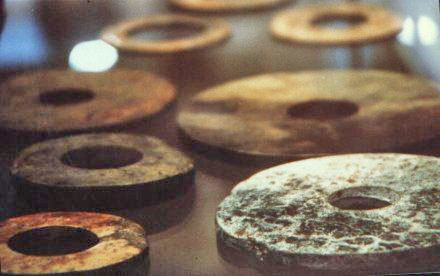
In each of the total of
716 graves he found a stonedisk with a diameter of about 1 foot and
a thickness of a third of an inch. These disks were engraved with
inscriptions of so far unknown origin.
Chi Pu Tei published
his findings stating that the skeletons were those of mountain
gorillas and that the disks were added by later cultures,
which lead to him being ridiculed by the Chinese archeologist
community.
1947: Dr. Karyl
Robin-Evans’ expedition
Shortly after World
War II the polish professor Lolladoff showed a strange
stonedisk to the English scientist Dr. Karyl Robin-Evans.
Lolladoff claims to have bought the disk in Mussorie
(Northern India) and that it is supposed to be from a mysterious
people called the "Dzopa" who had used it for
religious rituals.
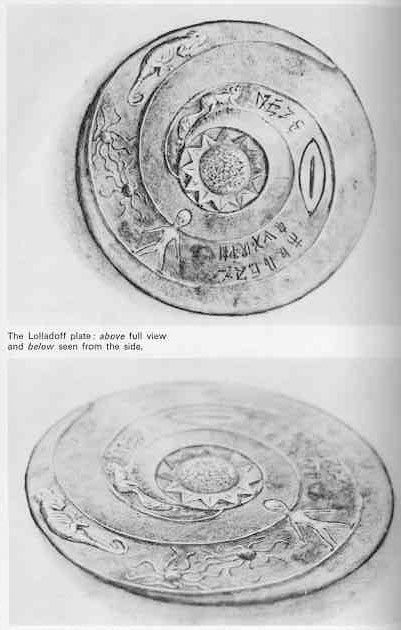
This plate called
'The Lolladoff plate' is a 12,000 year old stone dish
found in Nepal.
It clearly shows a disk shaped UFO (top of pic,
hard to see from the angle of the plate however).
There is also
a figure on the disc looking remarkably similar to a
Grey
alien.
Notice the spiral galaxy shape as well, with the
alien inside it and the ufo at the beginning of it.
Galaxies come in
spiral shapes and throughout India,
Egypt and Peru and other
ancient sites the spiral shape is very often seen.
This galaxy
spiral is probably there to tell us that they flew here from
another galaxy,
buy more probably the spiral was their symbol
signifying their knowledge of the universe,
as the spiral is the
most widely recognizable shape in the universe and in it's
creation.
The spiral shape also signifies energy.
The spiral is a
geometric shape found in many places throughout nature,
in many
ancient cultures it is portrayed and given great meaning.
Two of
the most popular spiral shapes however not always circular or
curved in shape
are the Fibonacci spiral and Golden spiral.
The
spiral is also well represented through sacred geometry.
The
spiral holds many mysteries, and its shape is universal,
its
constant depiction in ancient texts, pictures, and symbology is
obviously of great importance.
In 1947 the Dr. Robin-Evans made for the "mysterious land of the Dzopa",
travelling through Lhasa (Tibet) where he was
granted an audience with the 14th Dalai Lama.
On the way to the very inaccessible region to the northeast of
the Himalaya, the English scientist was abandoned by his
Tibetan carriers - they were terribly afraid of Baian-Kara-Ula - and only with tremendous effort did he
manage to reach his destination.
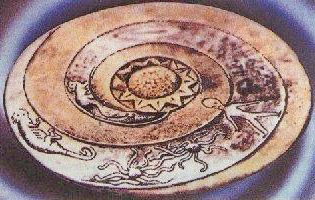
Image from Evan's
book "Sungods
in Exile", published four years after he died.
After having won the
faith of the locals, Dr. Karyl Robin-Evans was assigned a
language-teacher in order to introduce him to the basics of the Dzopa-language and so he learned from Lurgan-La,
religious guardian of the Dzopa, the history of
the Dzopa.
Lurgan-La pointed out that they (Dzopa)
originally came from a planet in the Sirius-system. There
had been - about 20.000 years ago and again in the year 1014 -
two exploration missions to earth. In 1014 the crash took place
that lead to the accidents survivors being unable to leave earth
again.
Dr. Karyl Robin-Evans
died in 1974.
The above report was released in 1978.
-
The Dzopa are often referred to as the
Dropa.
This is due to the fact that the sound of the second consonant
is in between a ’Z’ and an ’R’.
-
As Tibet wasn’t under the rule of China in 1947, Dr.
Robin-Evans trip could easily be arranged.
-
It is well possible that Dr. Robin-Evans was
received by a "lineholder" instead of the Dalai Lama
directly, a fact which could be used to verify the correctness
of Dr. Robin-Evans’ report.
-
Dr. Robin-Evans’ report dates the crash to
the
year 1014, all other sources however talk of a crash 12.000 years ago. This discrepancy remains unexplained so
far.
-
According to Lurgan-La’s history the Dzopa
would appear to be direct descendants of space travelling
"aliens"
1968: W. Saitsew & Prof. Tsum
Um Nui
In 1968 the Russian scientist W. Saitsew published a
sensational paper which raised a lot of interest in the subject of
extraterrestrials visiting earth in the past. Some of the
information presented in his paper were based on the work which
Prof.
Tsum Um Nui did in 1962.
1962: Prof. Tsum Um Nui
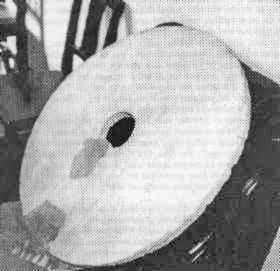 In
1962 Prof. Tsum Um Nui managed to partially decode and
translate the stonedisks and published his findings, which were
so amazing that the academy of sciences in Beijing at first
prohibited their public release. Prof. In
1962 Prof. Tsum Um Nui managed to partially decode and
translate the stonedisks and published his findings, which were
so amazing that the academy of sciences in Beijing at first
prohibited their public release. Prof.
Tsum Um Nui’s report
told the story of a group of beings - called the Dropa
- which had crashed their spaceship in the Baian-Kara-Ula
mountains 12.000 years ago and who, after realizing their
inability to leave earth again, had to put up with a rather hostile
environment in order to survive.
Prof. Tsum Um Nui published
this report after having received permission of the academy to do
so, which earned him the mockery of many an archeologist.
Saddened
by these events, Prof. Tsum Um Nui emigrated to Japan, where
he died in 1965.
• Tsum Um
Nui appears not to be a Chinese name but rather a phonetic
conversion of a Japanese name.
• No
ethnological minority with the name "Dropa" or "Dzopa"
respectively is recorded in China.
1968: W. Saitsew’s
paper "science or fantasy"
In the borderland
between Tibet and China there is the
cave region of the Baian-Kara-Ula mountains.
25
years ago, remarkable finds of tablets with writing and
hieroglyphics were made there. Several thousand years ago a
people whose looks chinese archeologists are only vaguely
familiar with, had been cutting phonograph record like stonedisks out of the hardest granite with a set of
completely unkown tools.
The 716 stonedisks found so far
also have a hole in their center just as phonograph records do.
From there, spiraling out towards the rim, are double-grooves.
These grooves of course are not like sound-tracks but rather the
most peculiar writing-system which has ever been found in China
and possibly even the world.
It took
archeologists and scientists over two decades to decipher it.
The contents are so fantastic that the academy of pre-history in
Beijing didn’t want to publish the report of the scientist
Prof. Tsum Um Nui at first.
Backed by four colleagues,
archeologist Tsum Um Nui stated:
"the
groove-writing tells of aerial vehicles which, according to
the stonedisks, existed 12.000 years ago".
In one place it says
literally:
"The Dropa
came down from the clouds with their airgliders. Ten
times the men, women and children of the Kham
hid in the caves until sunrise. Then they understood the
signs and saw that the Dropa came in peace
this time."
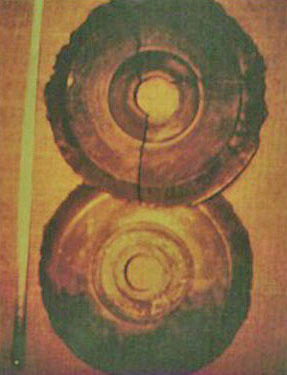 Finds
of the Dropa and Kham races
have been made earlier already in these mountain caves.
Archeologists were and still are unable to ethnologically assign
these only up to 4 ft. 4 in. tall humans. Finds
of the Dropa and Kham races
have been made earlier already in these mountain caves.
Archeologists were and still are unable to ethnologically assign
these only up to 4 ft. 4 in. tall humans.
There are no
similarities with the Chinese, Mongols or Ribetans. One
could of course suggest that a few thousand years ago a Kham literate was playing a joke, or that it was mere
superstition when he was talking about aircrafts.
But then, what
does one do about the statement, all sensations excluded,
reported in other groove-hieroglyphics of a great mourning about
the own airfleet’s destruction during landing in the very
inaccessible mountains and the lack of means to rebuild it.
The hieroglyphics of Baian-Kara-Ula appear to be so
mysterious to the Chinese archeology that only very careful
scientific use has been made of them. On one occasion a
sensational discovery had been made. The disks contain a lot of
cobalt and other metals.
When testing a disk with an
oscillograph a surprising oscillation rhythm was
discovered, just as if the disks with their groove-writing had
once been charged or had functioned as electrical conductors.
Nobody can tell what’s behind these 12.000 year old
stonedisks.
Assumptions would be
too risky and not objective enough.
But one is reminded of the
ancient chinese tale of the small and slender yellow people who
came from the clouds and were shunned by everyone due to their
ugliness - large, wide heads and very slender bodies - and
hunted by the "men with the quick horses" (Mongols?).
In fact
there had been finds of grave - and skeleton remains in the
caves from 12.000 years ago and it’s also a fact that these
finds, classified as remains of the Dropa and
Kham race, carried the signs of a small body frame
and very large heads.
The very first archeological reports
tell of an extinct mountain gorilla species. But has anyone
heard of ordered monkey-graves and writing- tablets? In 1940 the
archeologist Chi Pu Tei was widely mocked at for making
such a claim.
But Chi Pu Tei defended himself by
declaring that the stonedisks had been added to the caves by
later cultures.
The above text is a
translation of the original paper written by W. Saitsew and
has not been altered in any way.
|





 In
1962 Prof. Tsum Um Nui managed to partially decode and
translate the stonedisks and published his findings, which were
so amazing that the academy of sciences in Beijing at first
prohibited their public release. Prof.
In
1962 Prof. Tsum Um Nui managed to partially decode and
translate the stonedisks and published his findings, which were
so amazing that the academy of sciences in Beijing at first
prohibited their public release. Prof.  Finds
of the Dropa and Kham races
have been made earlier already in these mountain caves.
Archeologists were and still are unable to ethnologically assign
these only up to 4 ft. 4 in. tall humans.
Finds
of the Dropa and Kham races
have been made earlier already in these mountain caves.
Archeologists were and still are unable to ethnologically assign
these only up to 4 ft. 4 in. tall humans.